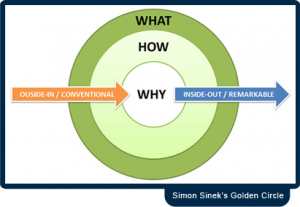By Rose O. Sherman, EdD, RN, FAAN
“All great leaders communicate in the same way. They always start with the Why”. Simon Sinek
 I was recently talking with an applicant to our graduate program. She is on steering committee in her hospital that is working on introducing new standards for their OB units. She told me she never anticipated the level of resistance that her committee is experiencing to the practice changes. She explained that the initial rollout had failed because staff felt like the changes were just a huge inconvenience being thrust on them by management. “I quickly realized” she said that “we had not explained the why – and how these were new national guidelines.” This important recognition gets to the heart of what Simon Sinek talks about in his book Start with Why. He points out that people won’t buy into what you do without knowing why you do it.
I was recently talking with an applicant to our graduate program. She is on steering committee in her hospital that is working on introducing new standards for their OB units. She told me she never anticipated the level of resistance that her committee is experiencing to the practice changes. She explained that the initial rollout had failed because staff felt like the changes were just a huge inconvenience being thrust on them by management. “I quickly realized” she said that “we had not explained the why – and how these were new national guidelines.” This important recognition gets to the heart of what Simon Sinek talks about in his book Start with Why. He points out that people won’t buy into what you do without knowing why you do it.
The Golden Circle
The conventional pathway that the leadership in many organizations use in presenting any change is to start with the what and then explain the how. To achieve remarkable results, Sinek explains that this order needs to be reversed. Whether your goal is to reach staff or patients, people will buy into why you do what you do versus what you do. In his book, Sinek used Apple as a great example of a company that has successfully conveyed the why in their work to consumers. Apple, for example, explains they do what they do to challenge authority. They explain what they do as designing beautiful products that are easy to use. What do they do? They happen to sell computers.
Starting with the Why
The why of what you do in your health care organization can often be found in your mission statement or sometimes in a theoretical framework that you have chosen for care. For many years, I practiced nursing in the Department of Veterans Affairs. The mission statement of the VA dates back to Abraham Lincoln “To care for him who shall have borne the battle, and for his widow, and his orphan” by serving and honoring the men and women who are America’s veterans.” This was the why of everything that we did. As a leader, I had this mission statement prominently displayed on the units and in my office. I remember as a nurse recruiter calling this to the attention of prospective applicants and asking them whether this was something that they could believe in.
Kaiser Permanente, a very large health system, has the following why in their mission statement “Kaiser Permanente exists to provide affordable, high quality health care services to improve the health of our members and the communities we serve.” With this clear why, it is easy to understand why Kaiser has been an early adopter of the accountable care organization model. ACOs are part of a new reimbursement strategy with health reform and to keep care affordable and accessible, this is a wise step. This same model can be taken down to the unit level. If the why in your unit mission statement is to serve our patients with compassionate, family-centered and evidence-based care…..then any discussion of a change such as open visiting hours should be brought back to this why.
Moving to the How
In the current health care environment, many organizations are challenged financially and leaders are being asked to implement new strategies to meet the demands of changes coming with health reform. This may result in changes in how you do what you do. Your how today is likely to involve designing strategies to provide the right patient the right care at the right time in the right place and at the right price.
Finishing with the What
The what should come last not first. Nursing staff need the context of the why and how before they hear the direct changes that might impact their practice.
Change is taking place in health care today at a incredible pace. Sinek has found in his research that leaders who use the golden circle of leadership communication from the inside out are more effective and gain the respect and buy in of their staff. This is advice worth taking.
Read to Lead
Sinek, S. (2011). Start with why: How great leaders inspire everyone to take action. Portfolio Trade Publishers.
Sinek, S. (September 2009 TedTalk) How great leaders inspire action.
© emergingrnleader.com 2015



 LinkedIn
LinkedIn Instagram
Instagram